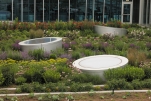Roof Garden for Work and Leisure

In previous issues of Green Buildings Magazine we wrote about the Rules of Resilient Design, developed in the form of an online guide by the American Society of Landscape Architects, ASLA. These recommendations should help people to protect themselves from natural disasters and other unexpected climatic events. One of these phenomena can be called a heat, which some scientists think is caused by global warming.
Extreme Heat 15 of the 16 warmest years on record have occurred during this century, according to the National Oceanic and Atmospheric Administration (NOAA). 2015 also marks the 39th consecutive year that the annual temperature has been above the 20th century average. Rising temperatures intensify environmental threats, such as drought and rising sea levels. Higher average temperatures also lead to increased energy use and exacerbate pollution, which in turn raises health risks.
According to the Inter governmental Panel on Climate Change (IPCC), there are also longer continuous stretches of higher temperatures that pose greater health risks than isolated hot days.
Heat-related illnesses, such as heat stress, asthma, and malaria (mosquitos carrying the disease will travel further as temperatures rise) are expected to claim an additional 250,000 lives between 2030 and 2050, according to the World Health Organization.
The effects of rising temperatures are pronounced in cities, where asphalt and concrete absorb and trap heat. This phenomenon is known as the urban heat island effect.
 Materials provided by The American Society of Landscape Architects
Materials provided by The American Society of Landscape Architects
Full content of this issue you can read here
The full version of the article can be read in our printed issue, also you can subscribe to the web-version of the magazine


